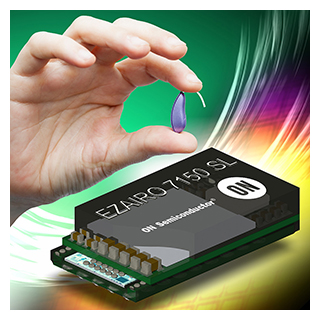Can you hear me now?
By unveiling the Ezairo Preconfigured Suite (Pre Suite), a development toolkit enabling turnkey solutions based on ON Semiconductor's Ezairo 7100 Digital Signal Processor (DSP), the company continues to grow its portfolio of ultra-low-power solutions for the hearing health industry. The wireless-enabled Ezairo 7150 SL is the first hybrid module to be supported by the Ezairo Pre Suite, with a firmware bundle that makes it easier to build wireless-enabled hearing aids.
It features Wide Dynamic Range Compression (WDRC), adaptive noise reduction, support for directional microphones, acoustic feedback cancellation, and environmental classification. Paving the way for easier development of mid-range hearing aids or upcoming Over-the-Counter (OTC) devices, the firmware bundle also provides support for advanced wireless features, opening the door for wireless fitting and advanced user control.

To help manufacturers tailor the Ezairo-based firmware bundles to their specific needs, ON Semiconductor provides a Windows-based software package which acts as a complete end-to-end user interface for developing next-gen hearing aids. The sophisticated software package includes features such as transducer modeling and calibration, parameter control, and live diagnostic tools that help fine-tune performance and optimise audio quality. Also included is a cross-platform Software Development Kit (SDK) which not only supports Windows, but mobile platforms as well including both iOS and Android, with wired or wireless communications over Bluetooth low energy (BLE) technology possible.
“The Ezairo Pre Suite represents a serious leap forward in supporting hearing aid development. It provides manufacturers with a complete easy-to-use, turnkey solution with all components needed to create a hearing aid or OTC device,” said Michel De Mey, Senior Director of Hearing Health Solutions at ON Semiconductor. “The mobile SDK is a compelling addition to the software, enabling the creation of new and exciting ways for users to interact with their hearing devices from their smartphones.”











